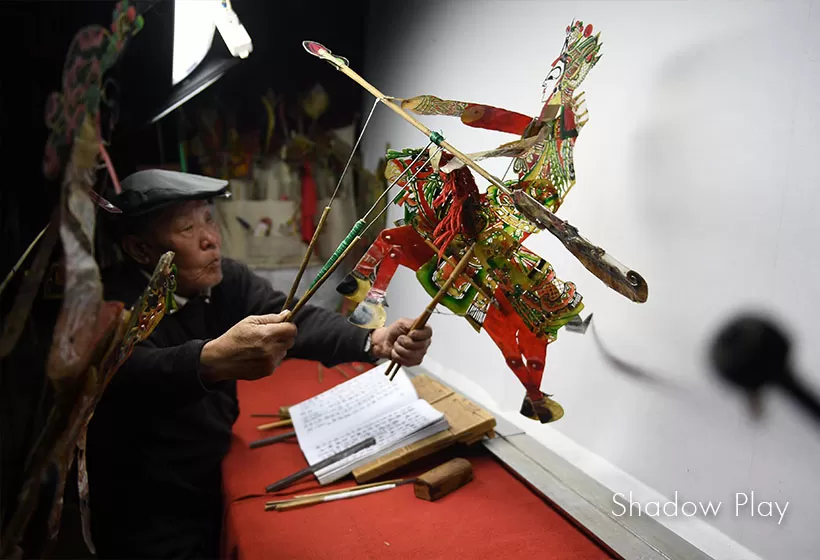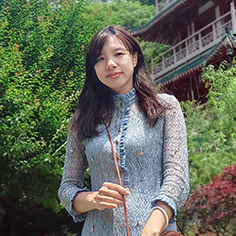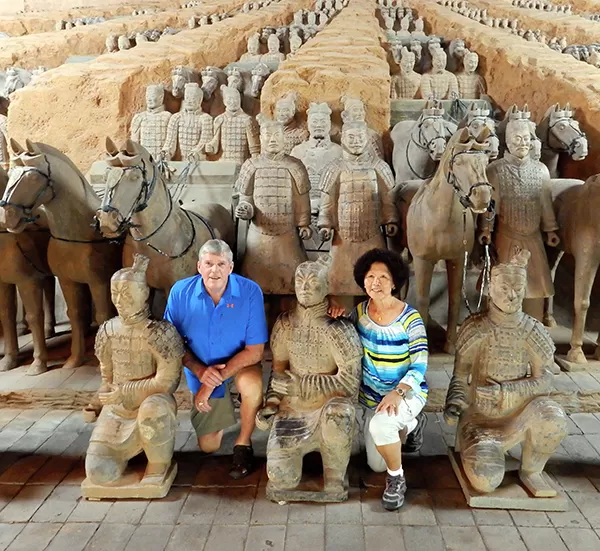Short Introduction to Xi'an Local Culture: History, Nation, Diet, Clothing, etc
Xi'an, the capital of Shaanxi Province, is a city steeped in unparalleled historical legacy. Renowned as the ancient capital of multiple dynasties and the starting point of the Silk Road, it boasts over 3,100 years of urban history and 1,100 years as a national capital. Xi’an has been known by many names throughout the ages,such as Chang’an, Xijing, and Xidu. Among them, “Chang’an,” meaning “eternal peace,” is the most well-known and cherished.
Home to the world-stunning Terracotta Army of Emperor Qin Shi Huang and countless historical treasures, Xi'an ranks alongside Rome, Athens, and Cairo as one of the "Four Great Ancient Capitals of the World".
Brief History
Early Civilization: Around one million years ago, the Lantian Man lived in this region, marking one of the earliest traces of human activity in China. About 7,000 years ago, during the Yangshao Culture period, the earliest prototypes of city walls began to appear, laying the foundation for urban development in the area.
During the Zhou Dynasty, Xi’an was known as “Fenghao,” marking the beginning of its long history as a capital city. Over the centuries, thirteen dynasties established their capitals here, including the Western Zhou, Qin, Western Han, Xin (established by Wang Mang), Eastern Han, Western Jin, Former Zhao, Former Qin, Later Qin, Western Wei, Northern Zhou, Sui, and Tang.
In the Qin Dynasty (221–207 BCE), as early as 361 BCE, Duke Xiao of Qin selected Liyang (in today’s Wutun Town, Yanliang District of Xi’an) as the capital. After the fall of the Qin, Liu Bang defeated Xiang Yu in 202 BCE and founded the Han Dynasty, naming it after the Han River and establishing the capital at Chang’an (whose ruins lie in the western suburbs of modern Xi’an). In 8 CE, Wang Mang usurped the throne and established the short-lived Xin Dynasty, bringing an end to the Western Han.
The Western Jin Dynasty initially set its capital in Luoyang but later moved it to Chang’an before its collapse. The Former Zhao regime, one of the states during the Sixteen Kingdoms period, was established by the Xiongnu people and made Chang’an its capital. In 352 CE, Fu Jian of the Former Qin declared himself emperor and also chose Chang’an (modern Xi’an) as his seat of power.
The Later Qin, established in 384 CE by Yao Chang of the Qiang ethnicity, continued this tradition by using Chang’an as its capital. In the Northern and Southern Dynasties period, the Western Wei (est. 535 CE) and its successor, the Northern Zhou (est. 557 CE), both made Chang’an their capital as well.
The Sui Dynasty (581–618 CE) established its capital at Daxing City, built on the ruins of Han Chang’an, marking a new era of unification. The Tang Dynasty (618–907 CE) later renamed Daxing as Chang’an and developed it into one of the largest and most cosmopolitan cities of the ancient world, an epicenter of politics, economy, and culture in East Asia.
During the height of the Tang Dynasty, Chang’an spanned an area of 84 square kilometers and had a population of over one million, making it the largest and most international metropolis in the world at the time. It served as a thriving hub of the Silk Road, facilitating extensive cultural and commercial exchanges between East and West.
In 1369, the second year of the Ming Dynasty's Hongwu reign, the city was officially named "Xi’an." Iconic Ming-era landmarks such as the city wall and the Bell and Drum Towers were constructed during this period.
In 1936, the Xi’an Incident significantly influenced the political landscape of modern China. After the founding of the People’s Republic in 1949, Xi’an rapidly developed into a major center for industry and culture.
Region Culture
Xi’an covers a total area of approximately 10,108 square kilometers and, as of 2023, governs 11 districts and 2 counties. With a permanent population of about 12.99 million in 2022, it is the most populous city in northwest China. As an international tourist city, Xi’an welcomed over 200 million visitors in 2023 and was named one of the world’s top 20 trending travel destinations.
As a major multi-ethnic city in northwest China, Xi’an is home to all 56 ethnic groups, with around 132,000 residents belonging to ethnic minorities, accounting for about 1.02% of the total population. Among them, the Hui and Manchu are the largest minority groups.
Xi’an’s folk culture is rooted in intangible heritage such as traditional opera, drum music, and festive celebrations. These elements reflect the city's deep historical legacy and everyday life, embodying the unique artistic style and cultural resilience of the northwest region.
Ethnic Minority
Among the ethnic minorities in Xi’an, the Hui people make up the largest group, with a population of 64,216, accounting for 75.28% of the city’s total ethnic minority population.
The Hui people in Xi’an are descendants of ancient traders who journeyed along the Silk Road and settled in this historic city, bringing with them Islamic beliefs, customs, and culinary traditions. As one of the largest ethnic minority groups in Xi’an, the Hui community is known for its strong sense of identity, resilience, and remarkable business savvy. Islam deeply influences their daily lives, and mosques. There are 19 mosques in Xi'an, such as the iconic Great Mosque of Xi’an stand as both religious centers and cultural landmarks.
The Hui are especially renowned for their rich food culture, with specialties like beef and lamb paomo, roujiamo, and hand-pulled noodles forming the heart of Xi’an’s vibrant street food scene.
Ethnic Minority Clothes
Traditional Hui women’s clothing typically includes a long robe and a sleeveless vest, often paired with a head covering known as a gaitou. The gaitou, or headscarf, is used to cover the head and face, usually concealing the hair, ears, and neck. The color of the gaitou varies according to a woman’s age and marital status. Elderly women tend to wear white, reflecting dignity and grace; middle-aged women often choose black, symbolizing calmness and maturity; while unmarried young women favor green, representing freshness and elegance.
Traditional Hui men typically wear long robes and favor a white round cap, which may have a flat top or a hexagonal shape. These caps are often embroidered with delicate patterns, reflecting both religious significance and cultural heritage.
Ethnic Language
The Hui dialect spoken in Xi’an is based on Guanzhong Mandarin, but it incorporates a rich blend of classical Chinese, as well as words from Arabic, Persian, Turkic, Mongolian, and other minority languages, along with commonly used terms from Confucianism, Buddhism, and Taoism. Its pronunciation and intonation are uniquely distinctive, reflecting the cultural fusion that has shaped the local Hui community over centuries.
Folk Custom
Islamic Festival
Eid al-Fitr (Kaizhai Festival), also known as "Rouzi Festival", is one of the most important holidays for the Hui people, marking the end of the fasting month of Ramadan. In Xi’an, it is celebrated at the end of the ninth month of the Islamic calendar. During the festival, Hui Muslims gather at mosques for special prayers and break their fast. In the days leading up to Eid, the Hui communities in Xi’an prepare traditional foods such as sanzi (fried dough twists) and youxiang (deep-fried cakes), which are shared with friends, relatives, and neighbors as part of the festive greetings.
Eid al-Adha (Qurban Festival) is another significant celebration in the Hui calendar, held on the 10th day of the 12th Islamic month. Known as a traditional agrarian festival, it is observed in Xi’an with rituals such as animal sacrifice, agricultural ceremonies, and a variety of celebratory events including singing, dancing, and traditional sports competitions.
Mawlid al-Nabi (Shengji Festival) commemorates the birth and passing of the Prophet Muhammad. Held on the 20th day of the third month of the Islamic calendar, the Hui community in Xi’an marks this occasion with Qur’an recitations, storytelling about the life of the Prophet, and other religious activities in local mosques.
In addition to Islamic festivals, the Hui community in Xi’an also participates in traditional Chinese celebrations.
Dragon Boat Festival (The fifth day of the fifth lunar month), locals prepare zongzi (sticky rice dumplings) and honor historical traditions. The City God Temple (Chenghuang Temple) hosts temple fairs on the 1st and 15th of every lunar month, with a grand sacrificial ceremony on the 8th day of the fourth lunar month, drawing large crowds and offering vibrant religious rituals.
The Lantern Festival (The fifteenth day of the first lunar month) sees Xi’an’s ancient city wall illuminated with colorful lanterns, coupled with riddle-solving and tangyuan (sweet rice balls), symbolizing reunion and festivity.
Diet Style
As the starting point of the ancient Silk Road, Xi’an’s cuisine reflects a rich fusion of flavors from across China and Central Asia. With a history spanning centuries, its food is renowned for its variety and bold tastes, including spicy, numbing, aromatic, and mild flavors. Thanks to Xi’an’s climate and geography, which are ideal for wheat cultivation, noodles and other wheat-based dishes have become staples of the local diet.
A single bite of roujiamo (Chinese-style meat burger) is enough to impress. Other must-try dishes include the hearty yangrou paomo (crumbled flatbread in lamb soup), the fiery youpo noodles with chili oil, and the famous Hulu Chicken, a traditional Chang’an specialty known for its crispy skin and tender meat. Xi’an offers a culinary journey that is both diverse and deeply rooted in history.
Read More local Food and Restaurants in Xi’an »
Cultural Heritage
Xi’an is home to two UNESCO World Cultural Heritage sites: the world-renowned Mausoleum of the First Qin Emperor and his Terracotta Army—hailed as the “Eighth Wonder of the World”—and five key sites that reflect the glory of the Silk Road: the Weiyang Palace of Han Chang’an City, the Daming Palace of the Tang Dynasty, the Giant Wild Goose Pagoda, the Small Wild Goose Pagoda, and Xingjiao Temple.
The city also boasts a wealth of intangible cultural heritage. These include Qinqiang Opera, one of the oldest forms of Chinese opera; Xi’an Ancient Music and Dance, a living legacy of Tang Dynasty court music; Guanzhong Shadow Puppetry, known for its vivid storytelling; and Xi’an Dough Figurines, exquisite folk art shaped by hand from colored flour.
Qinqiang Opera is the most representative form of traditional Chinese opera in Northwest China and one of the four major opera genres in the country. Originating during the Yuan and Ming dynasties, it is known for its powerful vocal delivery and bold, unrestrained performance style. In 2006, it was included in the first batch of China’s national intangible cultural heritage list.
Guanzhong Shadow Puppetry is an ancient folk-art form hailed as “China’s earliest animated film.” It dates back to the Han Dynasty and features intricately carved figures made from cowhide, sheepskin, or donkey hide. The art blends the carving style of Han dynasty stone reliefs with Song dynasty court painting techniques. Performances are accompanied by music and projected using light, bringing the figures to life in vivid storytelling.
Xi’an Drum Music is an ancient form of folk music often referred to as a “living fossil of millennia-old music.” Tracing back to the Tang Dynasty, it is celebrated for its unique performance techniques and rich, expressive forms. Ensembles typically consist of percussion and string instruments, such as drums, gongs, cymbals, pipa, and erhu.
Xi’an Dough Figurines, known as the “art at your fingertips,” are a traditional form of folk sculpture. Crafted primarily from wheat or glutinous rice flour and painted with vibrant colors, these figures are admired for their exquisite detailing and lively expressions. Themes often reflect auspicious symbols, blessings, and folk beliefs.
Customize Your Unique Xi'an Tour
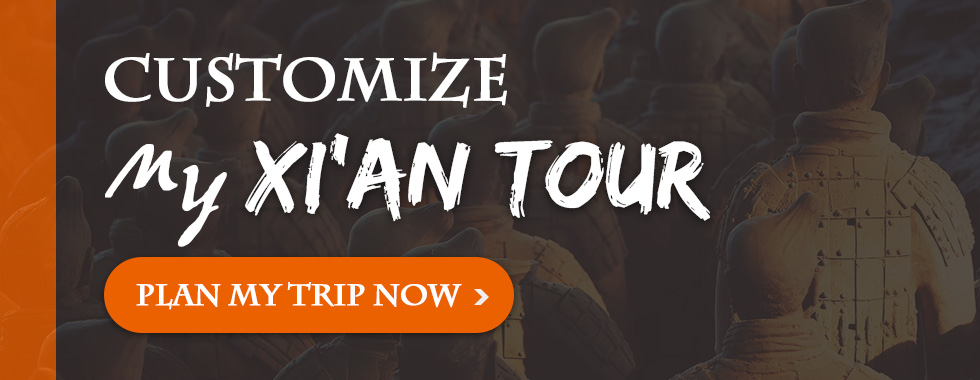
If you are interested in one of the Xi'an itineraries mentioned above, please contact us, and we will be happy to customize it and provide a quote tailored to your preferences.
Alternatively, if you would like to customize your Xi'an Tour, please visit our Xi'an Tour Customized Center. We assure you that you will receive a reply within 24 working hours.
Informative Articles for Xi'an 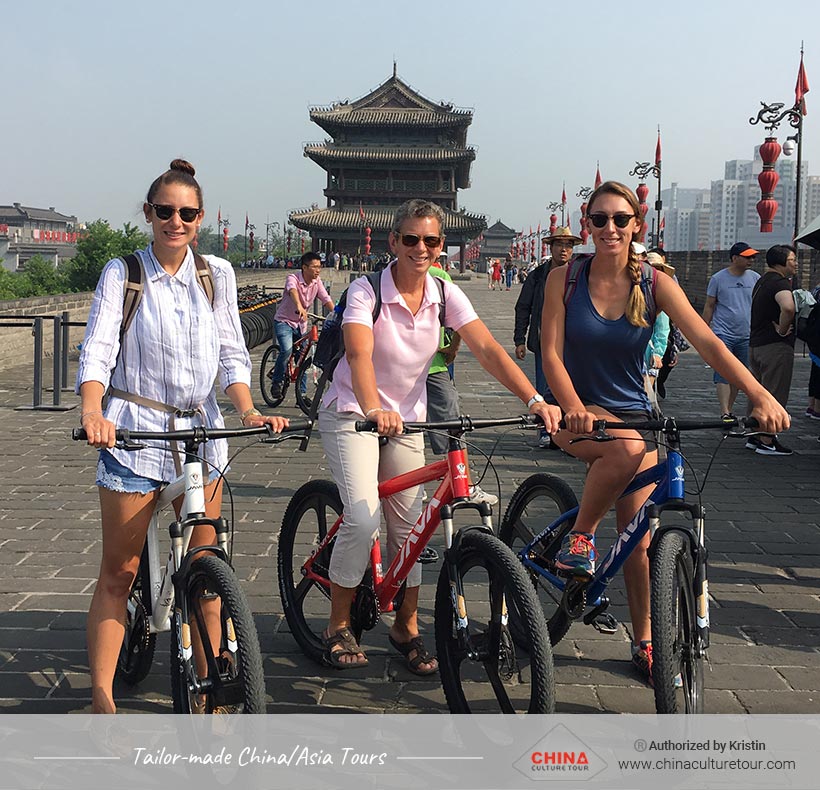 Xi'an
Xi'an
 Xi'an
Xi'an- Interesting Experiences and activities in Xian that can be put into your trip!
- Selected travel itineraries in Xian for your reference
- Customizable Xi'an Tours
- Top attractions in Xi'an
- Xi'an historical weather, the best time to visit Xi'an
- Brief introduction to the Xi'an local culture
- Unique perspective: best interesting things to do
- Top destinations: best places to visit in Xi'an
- Local food: what to eat while traveling in Xi'an
- Luxury hotels: where to stay in Xi'an
- Quick and time-saving to Customize a Xi'an Trip
GREAT FAMILY CHINA TOUR
JULY 2024 We wanted to thank Grace at China Culture tour for organizing a great tour of China. We enjoyed our Beijing - Xian-Chengdu -Guilin -Yangshuo - Shanghai trip. Our local guides Bruce in Beijing, Susan in Xian, Jane in Chengdu, Mike in Guilin and Mary in Shanghai took care of us…read more details »
Teng Han L from SINGAPORE
Ready to Create a Unique Dream Travel?
